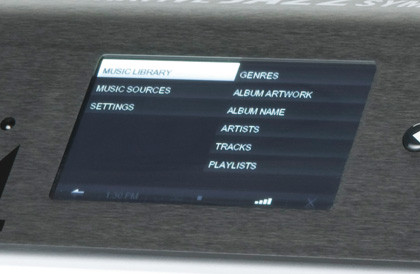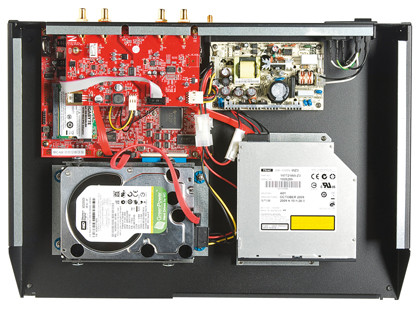TechRadar Verdict
Allows the music fan to dispense with physical storage media and download their albums from the hi-res internet sites
Pros
- +
The sound is alluring with hi-res
- +
Nice design
- +
Great interface
Cons
- -
Networking set-up is complicated
Why you can trust TechRadar
The Olive 4HD is a hard disk server and streaming media player that promises to put its fledgling manufacturer Olive on the map.
The company only began delivering products in 2005, yet of all the hard-disk players we have auditioned, only a very small number have provided a user interface quite as slick as that of the Olive 4HD.
Of course, the software underpinning any such device is easily the most important element – along with its sound, of course – in differentiating the product from its competition and Olive's proprietary Maestro software is superb.
With its simple elegance and its logical operation, you can create playlists, add or change album artwork and edit. Outwardly, it is neither overly complicated nor too minimalist. It strikes a comfortable balance and provides all that any user should need to rip and play CDs easily.
Box of delights
The 4HD comes equipped to operate over a wireless network, but for the best and most reliable performance, we recommend using the wired – Cat5 – connection.
Go into the Network Set-up menu and choose 'Wired' and 'Automatic' and in a few seconds the box will have interrogated your network and found itself an IP address and the internet connection. If, by chance, your network does not include any DHCP (Dynamic Host Configuration Protocol) service, which simplifies network management, you can select 'Manual' instead of 'Automatic' and enter the details yourself. Either way it is only a moment's work.
Sign up for breaking news, reviews, opinion, top tech deals, and more.
You access all the settings though the touch-screen along with, should you wish, the navigation buttons to its right.

CD ripping, the 4HD's primary function, takes a few minutes per disc, especially if you choose to store your music as uncompressed WAV or lossless FLAC files, which we also recommend if you want true hi-fi performance. And if you do not want true hi-fidelity, we have to ask why are you spending £2,200 on a server?
The Olive will also burn CDs or, more accurately, burn playlists to a CD. The device does not automatically back-up to a second internal hard drive: instead, there is a USB port to which users connect an external drive for that purpose. Olive wisely suggests performing backups while you sleep, because USB transfers are not exactly high-speed operations.
The 4HD provides both digital and analogue (preamp) outputs and its digital input allows users to employ the on-board DAC to convert the output of any other digital source. As we are using the Olive with a high-resolution Naim system we positioned it on a Quadraspire Sunoko Vent stand and fed its digital output into the Naim DAC through The Chord Company's Indigo digital cable, to extract the maximum information from its signal.

The internal DAC is of good enough quality, but in comparison to the best we've heard (the Naim DAC, for example) its sound seems rather closed in and flattened, with less dynamism. The stereo depth perspective also appeared rather shallow.
We also put some hi-res music alongside the standard resolution CD rips by connecting the 4HD to a networked computer and then dragging and dropping the music from wherever it is into the 'import' folder on the 4HD. An alternative is to play music sourced from a UPnP (Universal Plug and Play) server device which, in this case, is a mini-ITX computer running media server software.
Under the lid
The Olive 4HD, unlike some American built hi-fi, is well made but not extravagantly engineered. There are no gold-plated grab handles on show here. The most impressive feature is the shape of the enclosure, which reminded us of the distinctive lines of the exquisite, but unfortunately not equally as reliable Nytech calculator-style CTA series tuner/preamps of the 1980s.
The 4HD uses a proprietary DAC centred on a Burr-Brown 1792A, 24-bit/192kHz chipset, along with an extremely quiet hard drive and passive cooling to make it virtually silent in operation. Despite its hugely advanced technology, compared to the Nytech, it was considerably more reliable even despite having suffered a bump or two in transit.
It performed consistently and its only hiccough was swallowing a disc and refusing to return it. Unfortunately, the Olive has no means by which one can operate the eject mechanism manually, from outside. The second time a CD became jammed we removed the top half of the case and extracted the disc manually from the slim-line optical drive.

While the bonnet was up we also had a scout around and confirmed our suspicions that, like most of this breed, the 4HD was based upon a mini-ITX computer motherboard, with an additional board for audio I/O components. The interior build is satisfactorily workman-like, rather than obsessively audiophile and it was unfortunate that the review unit appeared to have suffered some internal disruption that caused the occasional disc-ejection problem.
As we understand it, Olive is investigating other options for shipping units across the Atlantic and contemplating minor revisions to the build.
Spellbinding sounds
We began listening with the albums we had ripped on the 4HD and its capabilities seemed commendable. It made a fine job of Albert Lee's Like This, his lightning-paced country-rock guitar coming across with admirable pace, detailing and tone.
His band's contributions are similarly well-handled and the overall presentation is musically coherent and rhythmically satisfying. Our only reservation comes with Lee and his drummer's sublime vocal harmonising on the cover version of the Everley's Crying in the Rain. This, when rendered at its best, is little short of magical.
Somehow, in some subtle manner, the 4HD falls slightly short of the mark in this – admittedly highly subjective – respect. The 4HD seems to thoroughly approve of high-resolution material and listening to a host of 24-bit/96kHz albums confirms this. It truly relishes Dawn Langstroth's Highwire album. Her vocals, in particular, are rendered exquisitely with a convincingly natural warmth – as opposed to any valve-like euphony – that helped establish an emotional bond with the listener.
The device caters equally well with her backing band, bringing its playing to life with considerable subtle detail, although it is her voice that remains in pole position. Its communicative power is spellbinding in tracks like Elevator Music, where the dynamic range between gentle and gentler is most keenly and deftly explored.
Another strength the 4HD displays with this album is its even-handedness and ability to keep recordings in perspective. There are, for example, some powerful bass lines on this album: these are clearly etched – and easy to follow – but they are never allowed to dominate the overall picture.
We then switched back to 16-bit/44kHz recordings for the acid test of Sia's album Some People Have Real Problems. Her voice and phrasing work with her band's accompaniments to deliver music that has an uncanny ability to touch one's heart and brain simultaneously. Her voice also has a particularly distinctive timbral quality that swings from sounding close to being broken, to amazingly powerful by way of sweet and fragile.
On Day Too Soon, her rhythm section locks into a funky, but gentle syncopated groove that allows Sia to simplify her phrasing and dynamics, but still create the enchantment she does on her more overtly athletic songs such as The Girl You Lost to Cocaine. The 4HD passes the Sia test with ease, emphatically revealing the music's detail in appropriate measure.
Then the Olive 4HD did something that truly amazed us: we even found time to appreciate the Rihanna Good Girl Gone Bad recording. It demonstrated that while this popular young lady might not know how many syllables there are in the word 'umbrella', she certainly knows how to pick producers for her music. On that track, the wall of over-damped drum samples demonstrate brilliant speed and attack and sound truly magnificent, despite their distant relationship with reality. The bass on Shut Up And Drive sounds just as implausible, but still creates a tremendous impact.
We ended with a little classical music, Tielman Susato's Danserye performed by the New London Consort. The Olive convincingly demonstrates that its strengths are not solely reserved for rock, pop, and R'n'B, but that it can be equally compelling with orchestral tunes, appearing here to be enchanted by the rich tonality of period instruments and the outstanding realism of the percussion.
Rhythmically and dynamically the music is excellent, while the flow and progression of the work is aided by the faithful recreation of note shapes and by maintaining the silences between them.
Ultimately, this born-in-the-USA server manages to produce a sound that will be instantly familiar to British audiophiles. It has fine musical communication skills that we value so highly here in Blighty. There's no doubt that the Olive 4HD certainly deserves Premier League status.
Follow TechRadar Reviews on Twitter: http://twitter.com/techradarreview
